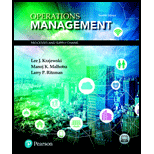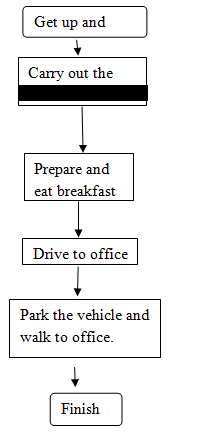
Concept explainers
Take a process that you encounter on a daily basis, such as the lunch cafeteria or the journey from your home to school or work, and identify the bottlenecks that limit the throughput of this process.
Interpretation: The barriers that hinder the process that is carried out regularly, i.e., a repeated process.
Concept Introduction: A bottleneck is the neck of a bottle, which restricts the flow of the liquid out of the bottle. In the case of process management, it refers to the sub-process and/or the activity which restricts the flow.
Answer to Problem 1DQ
Taking the process of getting ready for office and reaching the office:
- It is seen that preparing and eating breakfast is the constraint most of the time.
- At other times, driving to office becomes the constraint (due to allocated reasons).
Explanation of Solution
The process of getting ready for office and reaching the office is made up of many sub-processes/activities which can be sketched as follows:

In such a process, there is no tangible output but there is only one OUTCOME, that of reaching the office in time. The percent of times, the operator reaches in time is a measure of the efficiency of this process.
The outcome of reaching late may coincide with a longer time spent on preparing breakfast or longer time spent in driving.
Want to see more full solutions like this?
Chapter 5 Solutions
Operations Management: Processes and Supply Chains (12th Edition) (What's New in Operations Management)
Additional Business Textbook Solutions
Horngren's Accounting (12th Edition)
Intermediate Accounting (2nd Edition)
Horngren's Cost Accounting: A Managerial Emphasis (16th Edition)
Understanding Business
Marketing: An Introduction (13th Edition)
Financial Accounting, Student Value Edition (5th Edition)
- Examine the conflicts between improving customer service levels and controlling costs in sales. Strategies to Balance Both customer service levels and controlling costs in sales 1.Outsourcing and workforce optimization 2. AI-driven customer supportarrow_forwardhow can you gain trust in a negotiation setting?arrow_forward✓ Custom $€ .0 .on File Home Insert Share Page Layout Formulas Data Review View Help Draw Arial 10 B B14 ✓ X✓ fx 1400 > 甘く 曲 > 冠 > Comments Editing ✓ . . . P Q R S T 3 A Production cost ($/unit) B с D E F G H J K L M N $74.00 4 Inventory holding cost ($/unit) $1.50 5 Lost sales cost ($/unit) $82.00 6 Overtime cost ($/unit) $6.80 7 Undertime cost ($/unit) $3.20 8 Rate change cost ($/unit) $5.00 9 Normal production rate (units) 2,000 10 Ending inventory (previous Dec.) 800 11 Cumulative 12 13 Month Demand Cumulative Demand Product Production Availability Ending Inventory Lost Cumulative Cumulative Product Sales 14 January 1,400 1,475 15 FUERANZ222222223323333BRUINE 14 February 1,000 2,275 Month January February Demand Demand Production Availability Ending Inventory Lost Sales 1,400 #N/A 1,475 #N/A #N/A #N/A 1,000 #N/A 2,275 #N/A #N/A #N/A 16 March 1,800 2,275 March 1,800 #N/A 2,275 #N/A #N/A #N/A 17 April 2,700 2,275 April 2,700 #N/A 2,275 #N/A #N/A #N/A 18 May 3,000 2,275 May 3,000 #N/A…arrow_forward
 Practical Management ScienceOperations ManagementISBN:9781337406659Author:WINSTON, Wayne L.Publisher:Cengage,
Practical Management ScienceOperations ManagementISBN:9781337406659Author:WINSTON, Wayne L.Publisher:Cengage, Purchasing and Supply Chain ManagementOperations ManagementISBN:9781285869681Author:Robert M. Monczka, Robert B. Handfield, Larry C. Giunipero, James L. PattersonPublisher:Cengage Learning
Purchasing and Supply Chain ManagementOperations ManagementISBN:9781285869681Author:Robert M. Monczka, Robert B. Handfield, Larry C. Giunipero, James L. PattersonPublisher:Cengage Learning- MarketingMarketingISBN:9780357033791Author:Pride, William MPublisher:South Western Educational Publishing




